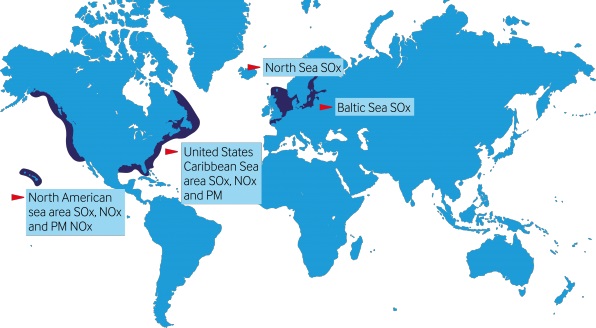The US Environmental Protection Agency (EPA) has released a bulletin addressing North American and US Caribbean Sea emission control areas (ECAs) compliance with Annex VI. The bulletin includes Frequently Asked Questions relevant to Exhaust Gas Cleaning Systems, Low Sulphur Fuel Requirements and NOx Tier III for dual fuel engines and other issues.
Exhaust Gas Cleaning Systems
Sludge or residues generated in treating exhaust gas scrubber washwater discharge
must not be discharged in waters subject to the VGP (i.e., including waters of the
territorial sea up to a distance of three miles) and should be delivered ashore to adequate reception facilities. VGP 2.2.26. The United States further expects MARPOL Annex VI Regulation 4 equivalency approvals to be conditioned upon compliance with IMO guidelines, including IMO’s 2015 Guidelines for Exhaust Gas Cleaning Systems. See Regulation 4.3. The 2015 Guidelines at 10.4 explain that EGCS residues should not be discharged to the sea, and Annex VI prohibits incineration on board.
EPA clarified in the response to comments for the 2013 VGP that a computational
calculation is not an approved method for demonstrating compliance with Vessel
Frequently Asked Questions General Permit (VGP) pH requirements. (RTC, p.981)
Low Sulfur Fuel Requirements—Dual-fuel engines
Regulation 14.4.4 of Annex VI contains a provision that postpones the application of the ECA fuel sulfur limits with respect to certain steamships that operate in the North American and U.S. Caribbean Sea ECA. This flexibility is available to steamships, regardless of flag, “built on or before 1 August 2011 that are powered by propulsion boilers that were not originally designed for continued operation on marine distillate fuel or natural gas.” As explained in our paper to IMO requesting this amendment to Annex VI (MEPC 61/7/6), this provision was adopted to
provide relief for older steamships that were designed for dedicated operation with heavy fuel oil. LNG tankers that burn boil-off gases and other dual-fuel steamships are designed for continued operation with natural gas and/or marine distillate fuel, so these vessels are not eligible for relief under Regulation 14.4.4.
NOx Tier III —Dual-fuel engines
Dual-fueled (gas and liquid) foreign vessels contracted on or after 1 January 2016 will generally be operated in gas mode within an ECA. Certain engines can achieve Tier III compliance without extra NOx control equipment. On such engines, some exceptions to gas mode operation will occur that require using liquid fuel. What is the acceptability of the following short-term and infrequent situations involving operation in liquid fuel mode at a Tier II NOx level with foreign vessels?
- Starting and stopping a four-stroke dual-fuel engine in liquid fuel mode.
- Stern propulsion, i.e., reversing the engine, in the liquid mode. Reversing is done for short periods during braking and maneuvering of direct drive ships.
- Maneuvering in low load operations (i.e., below 10 % engine load).
- Vessels transiting to/from shipbuilding or ship repair facilities which do not have access to LNG.
- Delays to vessels that may lead to all gas fuel being consumed (for example, port is closed by authorities due to an emergency / bad weather and the vessel cannot bunker more LNG until alongside a terminal.
- Operating a vessel in the event of temporary gas mode failure (i.e., fuel gas compressor trip, LNG fuel pump trip or low Methane Number of the fuel gas due to a long voyage and the vessel coming to the end of the fuel supply).
- Operating the vessel in case of non-availability of gas for any other reason out of the control of the vessel operator.
Explore more by reading US EPA’s bulletin herebelow:
Source: US EPA





























































